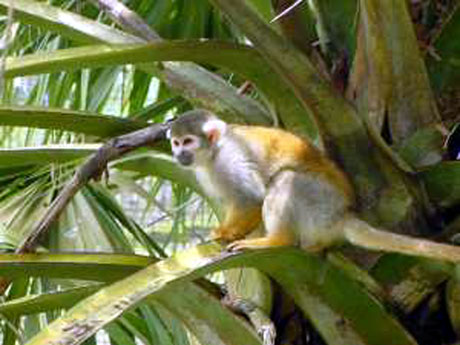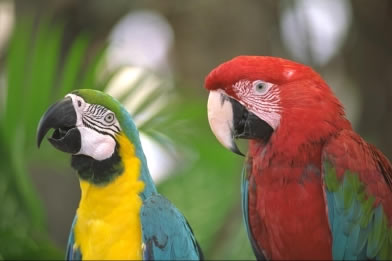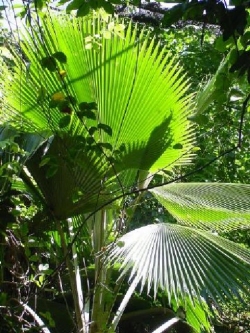




INTRODUCTION
This site will tell you about the following:
- Location
- Climate
- Animals
- Vegetation
- Destruction of the Rainforest

Tropical rainforests cover about 6% of the Earth's total land surface. They are mainly located around the belt at the equator. The climate of the rainforest is warm most of the year and has a lot of rain through most of the year. The climate is perfect for animals and plant growth. Even though the rainforests cover such a little amount of land mass of the Earth, they are home to the largest number of plant and animal species in such a concentrated area. Scientists believe that the tropical rainforests of the world might hold up to ninety percent of the plant and animal species on earth.
The Amazon drains the world's largest tropical rainforest, and is thought to have about 3000 species of fish, more than are contained in the entire North Atlantic. It is estimated that a typical patch of rainforest just six kilometers square contains as many as 1500 species of flowering plants, 750 species of tree, 400 species of bird, 150 species of butterfly, 100 species of reptile, and 60 species of amphibian. There are so many insects that they can only be guessed at, but one-hectacre (2.5 acres) may contain as many as 42,000 species.
CLIMATE AND LOCATION
Tropical rainforests cover about 6% of the Earth's total land surface area. They are mainly located around the belt at the equator, in the Amazon basin in South America, the Congo basin and other lowland regions in Africa, and they are both on the mainland and the islands off of Southeast Asia. They are especially abundant on Sumatra and New Guinea. Small areas are also found in Central America and along the Queensland coast of Australia.
The tropical rainforests climate is very warm, it has an average annual temperature of greater than 20 degrees celsius. They also have very little seasonal variation in temperature or day length, which is very favorable for plant growth. The tropical rainforest's temperature ranges from 20 to 25 degrees celsius and they have more than 250 centimeters of annual rainfall. The main climate control of the tropical rainforests are latitude.
ANIMALS
The animal of the tropical rainforest are a wide variety that adapt to their surroundings in many ways. One of the most common and effective camouflage is looking like a leaf dead or alive. The rainforest floor is scattered with dead leaves so the animals blend in very well and would be very hard to see from above like a bird would. Moths, treefrogs, and katydids also use this method. Animals also use coloring to warn predators that they are poisonous. Some of the brightly colored animals are just bluffing, but one that definately isn't is the poison arrow frog. The poison arrow frog comes in many different colors, the retiulated; dendrobates auratus is an aqua and black colored poison arrow frog. The D. leucomelas is a bright yellow and black colored poison arrow frog. The D. granuliferus' top half is red, its underside and back legs are green. The poison arrow frogs get their name because some rainforest tribes use the secretions from their skin to poison the tips of their blow gun darts.
VEGETATION
Young leaves if several jungle trees are red, and in the canopy or from the air such trees often appear to be in flower. Vegetation often interact with animals, birds and insects. The ceiba tree is covered in vivid red flowers that attracts numerous insects and humming birds, which drink the necter, collect the pollen, and fertilize the tree. The rainforest also have flowers that people have domesticated. The orchids come in many different colors, some are big and yellow and others are small and pink. Orchids are mainly found in Aisa and some parts in South America. Most of the rainforest leaves have pointed ends so that the rain can drip off. If this didn't happen the leaves might mold.
DESTRUCTION OF THE RAINFOREST
Rainforests are dissappearing at about 80 acres per minute, day and night. The rainforest is home to over half of all of the species known in the world. There are many undiscovered species that are being destroyed. Many of these species are possible cures for cancer and AIDS etc. Much of the destruction is done by Forest Alliance of British Columbia. Also as the population of earth grows, the need for forest products is increased and causes them to destroy even more rainforests to meet the demands. If this destruction continues, major climatic changes will occur. This will happen because when the forests are destroyed carbon dioxide is released which, in turn, causes the greenhouse affect. Ranching and logging for materials for houses, furniture, and paper products are also major destroyers of the rainforest. The tropical rainforest once covered more than 16% of the earth's total land surface, but now covers less than 6% of the earth's total land surface. Boycotts are the most effective ways of stopping destruction of the rainforest. Boycotting fast food resturaunts who use hamburger from cows who grazed on rainforest land, for example. Tourism also adds to the prevention. People seeing how the forest looks and all of the living going on in it causes them to want to make changes so that the rainforest can continue to grow.
 
|